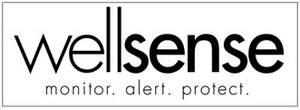Research Presented at Patient Experience Summit Demonstrates Benefits of the M.A.P(TM) in Helping to Prevent Pressure Ulcers
Study Shows Visual Biofeedback Plays Key Role in Effective Patient Repositioning
NASHVILLE, TN--(Marketwired - May 20, 2013) - Research being presented at an influential patient experience summit demonstrates improved patient outcomes in the prevention of pressure ulcers with the use of Wellsense's M.A.P™, the first-ever continuous bedside pressure mapping system. The research is the subject of a poster presentation at the 4th Annual Cleveland Clinic Patient Experience: Empathy and Innovation Summit at the Bank of America Conference Center in Cleveland on May 19-21. The study, "Enhancing Patient Experience by Optimizing Patient Repositioning through Biofeedback," showed that peak pressure was significantly lowered when caregivers used the visual aid of the M.A.P™ to reposition patients.
The M.A.P™ pressure sensing mat is made of an intelligent textile which constantly measures pressure from thousands of discrete points. The variations in pressure across a patient's body are depicted on a monitor, using a color scheme to help caregivers visualize high (red) to low (blue) pressure points, which enables them to easily identify and minimize areas of high pressure. The M.A.P™ serves as a supportive tool for caregivers by providing live, visual feedback as they reposition patients.
"This research confirms that pressure ulcers are indeed preventable with the right kind of technology," said Dr. Ronald G. Scott, lead study author and Director of Wound Care at a North Dallas Long Term Acute Care Hospital. "The use of visual biofeedback has a clear benefit to patient care and safety, as caregivers can be confident that they are effectively repositioning patients to help prevent the occurrence of pressure ulcers."
This research highlights the role biofeedback plays in effective patient repositioning, comfort, caregiver satisfaction and effectiveness, and pressure ulcer prevention. Biofeedback is a process that enables an individual to learn how to change physiological activity for health and performance improvement. The aim of the study was to provide caregivers and patients visual feedback in locating where pressure exists between the patient and the support system using the M.A.P. First, caregivers were asked to reposition a patient without visual aid. After the patient had been repositioned, caregivers were shown images of where pressure still existed, and then readjusted to limit peak pressure.
About the M.A.P™
The M.A.P™ is the first-ever, clinically proven, continuous bedside monitoring system that detects and depicts the variations in pressure across a patient's body, to aid in the prevention of hospital acquired pressure ulcers. Used on any existing bed, the M.A.P™ enables caregivers to visualize real time pressure distribution data to guide effective patient repositioning. The M.A.P™ live, color feedback empowers caregivers to easily identify early warning signs of risk to patient safety and has a demonstrated ability to improve upon a facility's pressure ulcer prevention program efforts.
About Wellsense
Wellsense was founded in 2009 to commercialize medical applications of a smart textile technology. The company's founders and management bring a strong track record of innovating and commercializing breakthrough technologies in consumer electronics and wound care. Wellsense USA Inc. and Wellsense Technologies, Ltd. are subsidiaries of Enhanced Surface Dynamics, Inc., a privately held company. Additional information is available at www.themapsystem.com.
Contact Information:
Contact:
Brian Baxter for Wellsense
bbaxter@lazarpartners.com
646-871-8491
